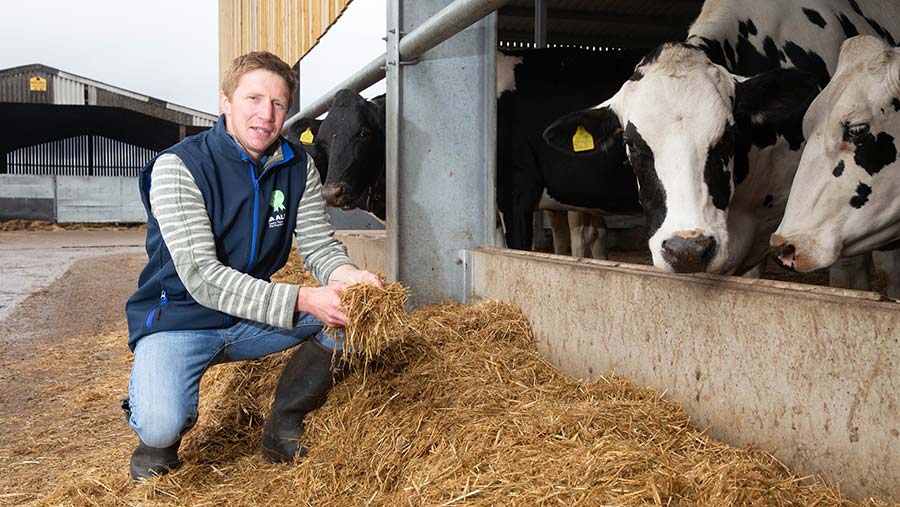Lucerne cuts farm’s reliance on bought-in protein
 © Tim Scrivener
© Tim Scrivener Farmers Weekly‘s Dairy Farmer of the Year 2021, Mark Larwood, is a seasoned grower of lucerne, a crop that other producers might consider as a way of displacing soya in cow rations.
He has been growing lucerne for 10 years to reduce reliance on bought-in protein and provide variety in the diet of his mostly autumn-calving herd.
“It is a consistent crop that grows good quantities of dry matter (DM); it has never let us down,” says Mark, who farms at at Oak House Farm, Norwich.
See also: 4 ways to further improve herd fertility
The crop reliably yields 11-12t/ha and analyses at 18-22% protein and 38-42% DM.
It scores less well on metabolisable energy (ME) – this is typically 10MJ/kg DM. But Mark feeds it with good-quality silage and maize, which together fill that gap.
Lucerne also offers a solution to spiralling fertiliser prices and pressure on dairy farms to become carbon neutral.
“It fixes its own nitrogen which is not only good from a cost point of view, but for the farm’s carbon footprint, more so now than ever going forward,” says Mark.
“In our experience, lucerne is a crop that will enable a farm to reduce its inputs.”
Farm facts: Oak House Farm
- Farms 250ha (617 acres), two-thirds owned
- Milks 250 Holsteins
- Year-round calving with strong autumn bias
- Twice-a-day milking
- Grows maize, grass, lucerne and cereals
- Six full-time employees shared between arable and dairy enterprises, plus one part time
- Milk sold to Arla/Aldi
Drought tolerance
With an annual rainfall average of 600mm and regular long periods of summer drought, Oak House Farm sits in one of the UK’s driest regions. In an average year, it can be challenging to grow grass from May to July.
Mark previously looked at establishing a grazing system, but as grass growth can’t be guaranteed, he chose not to go down that route. He also had a very limited area to use as a grazing platform.
Because of this, only low yielders in the 250-cow Holstein herd graze from March to October.
However, the dry conditions, in combination with the farm’s light, sandy loam soils, are a perfect fit for growing lucerne.
“I was looking for something that would grow in the dry period and would grow sufficient quantities of DM to keep silage stocks reasonable for the winter,” he explains.
“Lucerne is drought tolerant – it is extremely deep rooting, which allows it to draw up water in times of limited rainfall.”
It needs potash and phosphate indices of at least 2, he adds. He grows it on his lighter fields because “it doesn’t like getting its feet wet at all”.
“If you get flooding or pooling for more than a few days, it will kill the plant – and it doesn’t take many days for that to happen,” he says.
“We don’t often get periods of exceptional rainfall, but in years that we have, we have lost patches of lucerne.”
Consequently, planting areas on the farm must be chosen carefully. But, in general, growing lucerne is a way of producing a lot of DM with minimal inputs.
Establishment
Mark grows the variety Sibernol, with seed broadcast on free-draining soils in late spring, following grass, maize or cereal crops.
Slurry is applied before establishment at approximately 30cu m/ha.
Good establishment is essential: he recommends avoiding the shoulders of the season because lucerne is not a competitive crop in the early stages of growth. But he has never found it difficult to establish.
The crop can be drilled from April to the end of August, with the exact timing of sowing dependent on the previous crop.
Growing costs are favourable. In 2021, establishment and variable costs came to £312/ha, with seed accounting for £170/ha of that, and harvesting and baling at £180/ha for an average-yielding crop.
Weed controls are applied in the dormancy phase – in February each year – before the crop starts growing again.
“If you can get in with a spray early, the crop will be fine all year,” says Mark.
Rather than grazing the lucerne, it is cut for silage, and followed with grass, maize, or cereals.
Feed ration
The crop fits well into a multicut system as it is suitable for cutting every 30-35 days. At Oak House Farm, four cuts are taken annually.
“When we cut it, we try not to move it around too much, or the leaf will shatter, because the leaf dries out quicker than the stem,” he says.
The leaf contains up to 70% of the protein in the crop, so minimising leaf loss must be a priority.
Mark harvests the crop as round bales, but it can be clamped. When clamping, treatment with an additive is recommended.
Milkers are fed 6kg lucerne (freshweight) as part of a total mixed ration (TMR), along with grass and maize silages.
The lucerne helps to maintain milk composition at a rolling average of 4.4% butterfat and 3.32% protein.
The diet is formulated to deliver on yield and milk composition as Mark’s supply contract with Arla features liquid and compositional variations (see box).
Rapemeal and feed-grade urea are also included in the TMR, but lucerne reduces the protein requirement.
Total mixed ration for milkers at Oak House Farm
- 6kg lucerne silage
- 32kg maize
- 8.5kg grass silage
- 6kg brewers’ grains
- 5.8kg caustic barley
- 4kg rapemeal
- 2kg beet pulp nuts
- 0.15kg mineral
- 0.15kg limestone flour
- 0.3kg protected fat
- 0.14kg feed grade urea
- 5kg water
Crop rotation
The area Mark uses to grow lucerne may increase in the future, but he says the main challenge is fitting it in with the rest of the rotation.
In the planting year, it needs to be established early and it doesn’t produce a big crop.
“In that first year, we are sacrificing production,” Mark admits. “But going forward, we get four to five years, possibly longer, of full production. After five years, it starts getting a little bit thin and weeds then become an issue.”
Lucerne as a source of long fibre
Mark’s nutritionist, Ben Watts of Kite Consulting, describes lucerne as a “really good source of highly digestible fibre”. “A little goes a long way in the ration,” he says.
Ben reckons more farmers should consider growing it – even those with heavier land, if it is well drained.
Farmers need to increase their confidence in it, he says. “If you are looking for a long fibre source, lucerne would be something on my agenda.
“It will grow practically anywhere – the only region where it might struggle is in the North in cold, wet soils.”
For farmers who think lucerne might work in their system, Ben recommends visiting a farm with a similar land type and rainfall level that is growing the crop.
Enter the 2022 Farmers Weekly Awards
 The 2022 Farmers Weekly Dairy Farmer of the Year is sponsored by Virgin Money.
The 2022 Farmers Weekly Dairy Farmer of the Year is sponsored by Virgin Money.
Join Farmers Weekly in celebrating the farming industry and recognising the hard work of UK farmers and enter the awards today.
Alternatively, nominate a deserving individual for an award.
For more information about the 2022 Farmers Weekly Awards, visit the official Farmers Weekly Awards website.
